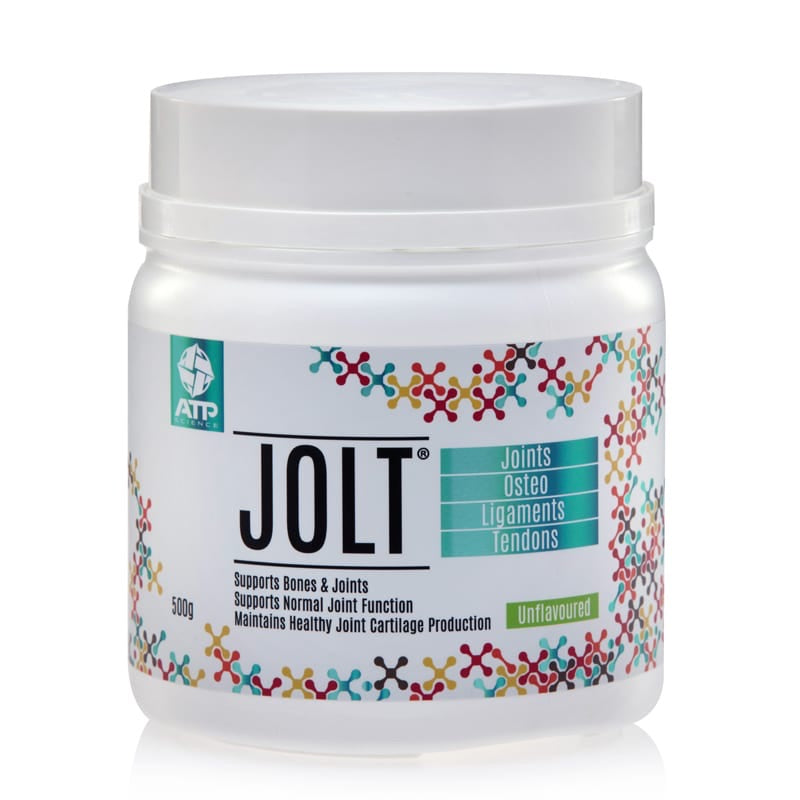



or make 4 interest-free payments of
$17.50 AUD
fortnightly with
![]() More info
More info
Hydrolysed collagen contains an abundance of amino acids that can contribute nutritional support in the synthesis of collagen and for the maintenance of normal healthy collagen status in the body. Here are some aspects of what collagen peptides can do:
Each serve of ATP Science JOLT® contains 15g of “specific hydrolysed collagen peptides”
1 full 5g serve of Fortibone® – Specific Collagen Peptides increase collagen components in bone.
1 full 5g serve Tendoforte® – Specific Collagen Peptides increase collagen components in tendons/ligaments.
1 full 5g serve of Fortigel® – Specific Collagen Peptides increase collagen components of Cartilage.
Collagen is a major essential component for the fascia coatings and linings that separate the red meat of our muscles. The collagen is also needed for the bones and joints, all of the long strips of tendons and ligaments attaching muscle to bone and bone to bone across the joints. The white parts on the muscle you see in most anatomical pictures must be nourished through the diet. As you will notice if you do, it makes up a large part of you. Does collagen make up a large part of your diet too?
Did you know…

As seen above in this diagram – the roles of collagen are vast and complex in nature, we have broken down the placement of collagen in the following structures of just muscle itself and its connective capacity to bone:
(Refer to the diagram below to see the collagen throughout.)
In the image below, you can see the collagen connective tissue coating around the bone actually continues as cartilage on the ends of the bone; that provides cushioning inside a joint and also across the joint capsule to the next bone via the ligaments. Then take look deep inside the bone, see that collagen web-like infrastructure, it’s incredible!

Image Source: https://www.news-medical.net/health/What-is-Cartilage.aspx
This may surprise many people, but bone is mostly made of collagen. Bone is in fact living, growing tissue in our body, not just a hard set in place structure like many assume. Collagen is the protein that provides a soft framework, and calcium is a mineral that hardens the framework, bone is built and broken down constantly over the course of our life. This combination of soft flexible collagen and hard shell-like calcium makes bone strong yet flexible enough to withstand multiple types of stress.
30% of your whole-body protein is collagen. What % of your dietary protein is collagen? Are you getting enough?
Collagen has a very unique protein structure, pay particular attention to the hydroxyproline, proline, and glycine contentof collagen protein compared to other dietary protein sources. Collagen has a different amino acid profile supplying collagen-specific nutrients. In the image below we can see these in bold to their extent of difference in comparison to other dietary protein sources.
This is important because you need these three amino acids to make up most of that springy triple helix-like structure of collagen forms in the body.

Body acidity has often been blamed for poor bone and joint integrity and function. In fact, body tissue acidity has been blamed for a lot of bad things. This area of research is on-going and there is not adequate data to make any statements regarding whether dietary acid does in fact create problems across a population or only experienced by certain individuals.
Many people will look for ‘alkalizing diets’ or investigate acid: alkaline foods with the aim of reducing pain. Collagen peptides have been shown to have an alkalizing effect with a negative (this is what you want to aim for) potential renal acid load, 20g of collagen is similar to 100g of green broccoli in this regard; as opposed to egg and whey proteins that were adding significant acid load to the body. Higher acid load is believed to be detrimental as the body strips other components of the body, like bone calcium, in order to balance the acid load. 15

Take one 15g serve of ATP Science JOLT® daily.
You can add to any hot or cold food and drink or add it to your cooking or in your favourite smoothie, shake or bake.
For recipe ideas and serving, suggestions check out our collagen-loving recipes on the website! This, like our NOWAY® Protein is heat stable and can be used in all your cooking adventures!